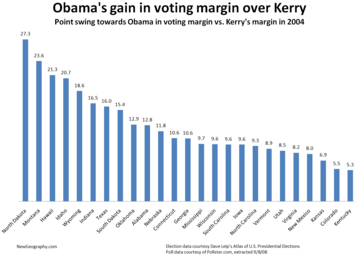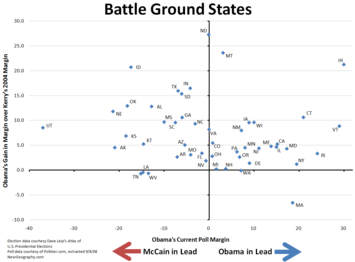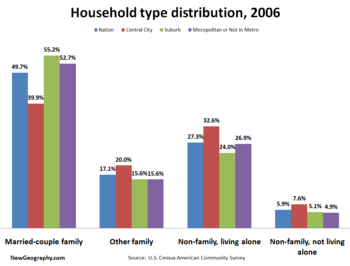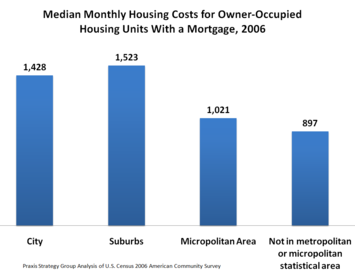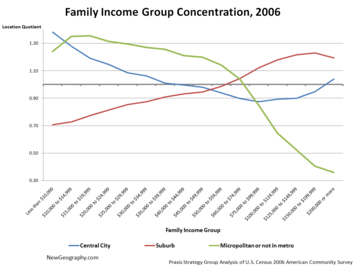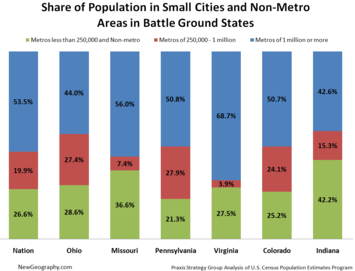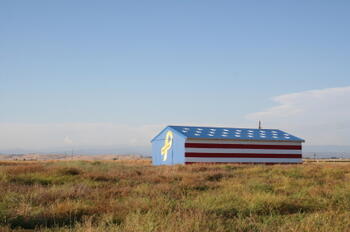
By Joel Kotkin and Mark Schill
Perhaps no geography in America is as misunderstood as small towns and rural areas. Home to no more than one in five Americans, these areas barely register with the national media except for occasional reports about the towns’ general decrepitude, cultural backwardness and inexorable decline.
Yet in reality this part of America is far more diverse, and in many areas infinitely more vital, than the big-city-dominated media suspects. In fact, there are many demographic and economic dynamics that make this part of America far more competitive this year than in the recent past.
Both parties have acknowledged the importance of this battlefield through their choices for vice presidential nominees. Barack Obama’s running mate, Sen. Joe Biden, is being touted not so much as a Washington foreign policy wonk but as the “scrappy kid from Scranton” — even though he has represented Delaware in the Senate for 35 years. Even more obvious is John McCain’s tapping of Alaska Gov. Sarah Palin, a former small-town mayor from a rustic state without anything close to a major metropolitan area.
Even though many very small towns — with, say, fewer than 10,000 people — have continued to decline in population, there’s a significant demographic and economic rebound taking place in a host of somewhat larger communities. Places such as Sioux Falls and Fargo in the Dakotas as well as Asheville, N.C.; Wenatchee, Wash.; and Springfield, Mo., have been drawing a steady stream of people and businesses from both big cities and suburbs.
This dynamic could provide some welcome surprises for Democrats and potential nightmares for Republicans. During the primaries, Obama startled observers with his ability to win over Democratic voters in places like the Dakotas, Montana, Kansas, Nebraska and Indiana. More importantly, according to recent polls, he is running between 10 points and 30 points ahead of John F. Kerry in 2004.
Where are these new Democratic voters coming from? Most of Obama’s primary wins came in what may be seen as the new heartland, a widely dispersed group of fast-growing smaller towns and cities stretching from the Sierra Nevadas to the Appalachians. He did particularly well in college towns as well as those places where high-tech and cutting-edge manufacturing companies have set up shop over the past decade.
This demographic and political dynamic has been building for years. In 2004, even Kerry came close to winning places such as Wisconsin Rapids, a small city of 17,500 in the central part of the state. Although the area has lost some high-paying blue-collar jobs in the paper industry, it has also attracted a growing number of sophisticated companies such as software firm Renaissance Learning, which employs more than 750 in the area.
Some of these workers are originally from the area, but many others bring with them tastes and opinions forged in Silicon Valley, Raleigh-Durham or the Massachusetts tech corridor. Their politics may not be Chicago liberal, but people settling in such emerging “virtual suburbs” tend, like their tech-oriented counterparts, toward a pragmatic, mildly liberal politics.
Other demographic groups are also changing the political complexion of some of these areas. Hispanics, for example, have been moving in large numbers to rural and manufacturing areas in the Great Plains and rural South which, until recently, were dominated by culturally conservative Anglos.
At the same time, affluent baby boomers from the coasts and large Midwestern cities — some retired, some working via the Internet — are also flowing into some of these places. Surveys of older Americans find far more would prefer to resettle in small towns than in big cities. Some of the fastest growing towns for seniors include Missoula, Mont.; Eugene, Ore.; Moscow, Idaho; and Charlottesville, Va.
As a result, these areas have become more cosmopolitan in their outlook. It is no longer unusual, for example, to see Indian, Chinese and other foreign-born professionals — or Asian restaurants or edgy coffeehouses. Fargo, once the very definition of staid, now boasts an excellent boutique hotel, a clothing store catering to metrosexuals and several pricey restaurants.
These shifts have not escaped the notice of the Obama campaign, which has put 50 campaign workers and 100 volunteer teams in North Dakota, long considered a lock for Republicans in November. Similar deployments are taking place in other rural states.
Yet it may still be a stretch to see some of these places voting for a big-city liberal like Obama. It’s one thing to support homegrown populist Democrats such as North Dakota’s Sen. Byron Dorgan or Montana Gov. Brian Schweitzer, who have a fine sense of how to negotiate the sensibilities of their constituents on issues of farm subsidies, guns or gay marriage.
McCain should hope Obama’s Hyde Park intellectualism and liberalism won’t play well beyond more affluent recent migrants and students. McCain may not win as big as President Bush did in 2000 and 2004, but he could hold on to enough rural and small-town voters to keep these states in the Republican column. McCain’s moderate image may hurt with some evangelical voters, but at least outside of the South, this may keep more moderate, younger and recently arrived voters in the fold.
Finally, the fact that many small towns are doing relatively well may make voters somewhat less likely to bolt the GOP. Few places in the countryside are suffering anything like a Dust Bowl-level catastrophe, although some now worry about a looming decline in commodity prices. And on some issues, such as fossil fuel development, McCain can appeal to constituents of small towns that have been enjoying an energy-fed boom. Pushing American energy development will work well in these areas, although the Arizona senator’s opposition to ethanol subsidies could hurt in others.
And even in rural places worst hit by the economy — such as traditional, manufacturing-dominated small towns in Indiana, Ohio, the Carolinas and Pennsylvania — Obama has yet to prove himself. In almost all these places, Hillary Rodham Clinton triumphed easily in the primary, usurping the grass-roots populist message. Obama has yet to show that knack.
Rural and small-town areas have fewer very poor constituents and a greater concentration of middle-income voters than cities, and far fewer wealthy households than cities or suburbs. These mostly white, working-class voters — heavily concentrated in states like Wyoming, West Virginia, the Dakotas, Montana, Maine, Idaho and Kentucky — could be the key to winning the micropolitan and small-town electorate. And these places could prove a critical battleground.
There are two regions where these voters might matter most. One is the sparsely populated Great Plains states that once represented a solid block of Republican strength. Obama not only has the chance to steal some electoral votes but also could divert McCain’s resources in more traditional battleground states.
The other is a series of traditional battleground states: Ohio, Missouri and Indiana. If Obama can gain some of the traction Clinton achieved in these states’ small towns and cities, McCain’s chances fade to almost nil.
Joel Kotkin is a presidential fellow at Chapman University and executive editor of newgeography.com. Mark Schill is an Associate at Praxis Strategy Group in Grand Forks, N.D., and the site’s managing editor.
Other articles in the Three Geographies Series:
The Three Geographies
Urban America: The New Solid South
